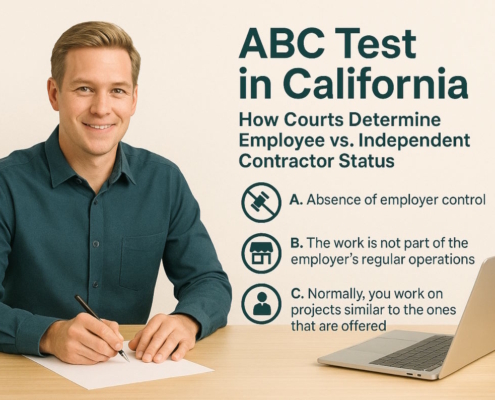What are the stages of the recruitment process?
The full-cycle recruitment process is beneficial for the recruiter, the company, and the job applicant. This article will take a closer look at the recruitment process, including its pros and cons, and the six primary steps of the recruitment process.
The recruitment process, known as full-cycle recruitment or end-to-end recruitment, describes the entire process of recruiting. This process involves a recruiter from beginning to end. There are six main steps in the recruitment process: preparing, sourcing, screening, choosing, hiring, and onboarding.
Every phase of the recruiting cycle, from filling positions and finding prospects to extending job offers and onboarding new hires, can be finished by a full cycle recruiter.
The individual in charge of full-life cycle recruiting may vary depending on how big the organization is. This is frequently the HR generalist who also serves as a full-cycle recruiter in a start-up or smaller business.
Each member of the recruitment team at a larger company’s HR department typically specializes in a certain step of the hiring process. Still, there will always be one person in charge of everything.
Of course, businesses may also choose to contract out the whole hiring procedure.
Benefits and drawbacks of the recruitment process
Let’s examine a few advantages that come with end-to-end hiring.
Advantages
Responsibility: It is obvious who is in charge of that process as well if there is only one person overseeing the complete procedure.
Experience of the candidate: The importance of a positive candidate experience has been discussed extensively. It’s easy to see how the applicant experience would be enhanced by having only one point of contact for the duration of the recruitment process. During the process, applicants know exactly who will be mentoring them, as opposed to communicating with multiple people at once and being unsure of who to contact and when. They will feel more at ease during what can be a very stressful time. Being involved at every stage of the process gives the recruiter a great chance to develop a deeper connection with the candidates. Through more individualized communication, they will be able to improve their experience, which will benefit them as well.
Shorter hiring time: The duration of time between a job applicant’s application and acceptance of an offer is known as the “time to hire.” Thus, the following information is provided by the time to hire metric: Recruiting efficiency. Simply put, a lengthy hiring procedure is a sign of a lazy, ineffective workflow with needless obstacles.
A couple weeks is a more appealing time to hire than three months in the eyes of potential candidates. Thus, a quicker hiring process will create a more positive applicant experience.
Preventing needless delays is possible when a single individual oversees the entire process. An HR manager can rely on fewer people when they oversee each step of the hiring process and mentor prospects through it rather than having a different individual handle each step separately.
But for this to be effective, the individual in charge of the hiring process needs to be extremely meticulous and well-organized, among other qualities.
Everyone involved can clearly see who is in charge when a full cycle recruiter holds that position. Should there be any delays, the candidate or hiring manager will know who to contact to get an explanation.
Drawbacks
There are two sides to everything, and the end-to-end recruitment process is no different. There are some disadvantages to this recruitment strategy that are worth discussing.
Not appropriate for all kinds of companies: There is a ceiling to how many candidates one person can manage at one time when they are involved in every stage of the hiring process.
The pros of a better applicant experience and a shorter hiring timescale diminish as you surpass that threshold. This is simply a result of the full cycle recruiter’s limited time to handle every candidate. This indicates that smaller businesses or highly specialized professions are especially well-suited for full cycle recruiting.
Requires a wide range of skills: There’s a good reason why employees in larger companies frequently have specialized knowledge in a certain area of recruiting. Based on the size of the company, their recruitment team may include a manager, a talent sourcer, a recruitment assistant, and multiple recruiters. This is due to the fact that every phase of the hiring process calls for a unique combination of abilities and expertise. For instance, sourcing applicants is not the same as negotiating offers or adjusting to new hires. It can be difficult for one person to become proficient in every one of these areas.
Naturally, there are technologies available for every phase of the hiring process to aid in the work of the full-cycle recruiter. However, learning how to utilize and staying current with technology can still take up a significant amount of their time. In the section below, we’ll provide a few examples of various forms of technology that can be helpful.
Also, a word regarding soft skills is in needed. Skills like communication, listening, and relationship-building with hiring managers and candidates are critical for a complete cycle recruiter. Beyond the more technical skills required to work with HR and recruiting tools, they will also need to master these soft talents.
The entire recruitment process in six steps
We’ll focus on the actual full cycle hiring procedure in this part. We’ll go over each of the six phases and how the full cycle recruiter fits into each one.
- Getting ready
It’s important to get details from the hiring manager at this point. The recruiter will schedule a time for the vacancy intake with the hiring manager as soon as the job request has been accepted internally.
The hiring manager and recruiter will go over the precise qualifications for the new role during the intake. It covers the necessary competencies, a good candidate’s personality, their function in the team, and their skills.
The recruiter will create an inclusive, concise job description (for internal use) using the data collected during the vacancy intake.
They will then draft the job posting in accordance with the job description (or delegate this task to a copywriter). The external text that candidates will read is the job posting, also known as the job advert.
- Sourcing
When the job advertisement is prepared and the groundwork for the applicant search has been completed, it’s time to begin the sourcing process. If the full cycle recruiter, for instance, is solely concentrating on highly specialized roles, this is where it gets easy.
The number of possible sourcing channels is significantly reduced if you are simply seeking individuals in a particular field. You will then be able to monitor each channel more effectively as a result. It also assists you in determining which channel offers you the most successful applicants, etc.
Concentrating on specialized positions also facilitates the creation and upkeep of a talent pool, which is a database including all the profiles of individuals interested in working for your company.
A talent pool can be an excellent source as well, giving you access to passive applicants who may be difficult to contact with and acting as a safety net in the event of an unexpected departure.
The recruiter will communicate with the hiring manager on a regular basis during the sourcing process to provide them with progress reports.
To make this phase of the hiring process go more quickly, you can use a variety of sourcing tools. Hiretual, a sourcing system designed by recruiters for recruiters, is one of these.
- Screening
There are various methods for doing the preliminary screening of candidates.
Screening resumes: This is the method that is used the most. It aids the recruiter in determining whether applicants meet (some of) the requirements listed in the job description. There are many of solutions out there that can handle the work for you in order to facilitate this kind of screening. They range from resume screeners that employ AI to forecast the quality of hire to resume screening tools that are integrated into applicant tracking systems.
Chatbot/phone screening: A phone screening usually follows the resume screening. This aids in coordinating expectations between the company and the applicant. There is a checklist that the recruiter can go over. Topics including compensation and benefits expectations, full-time versus flexible commitment, start date, and other potentially deal-breakers may be covered throughout the screening process. A chatbot can also take over here since it’s a very standard routine.
Pre-selection: It is an effective screening technique that aids in preventing possible mismatches. Pre-selection tools offer tests that aid in predicting the quality of the new hiring, such as personality assessments, job samples, cognitive exams, and other tests.
A realistic job preview may also be included in pre-employment evaluations. This gives candidates a more accurate impression of the position by highlighting both the good and the bad aspects of the work. Better hires result from this since it helps to match expectations between the employer and the candidate.
These pre-selection exercises are frequently employed for positions that receive a large number of applications. To control candidate expectations, a complete cycle recruiter can provide a realistic job preview, such as a video depicting a typical day in the life of the position.
Reducing the pool of applicants to a manageable three to ten individuals is the aim of this step of the hiring process. Video or in-person interviews are available for these prospects.
- Choosing
This phase of the hiring process entails assigning tasks, setting up interviews, taking part in the interview process, and giving candidates feedback. It’s also important to keep the hiring manager engaged and to have a positive relationship with them.
The complete cycle recruiter must watch multiple balls at once in this situation. Scheduling plays a major role in this phase of the full cycle hiring process. Interviews with candidates must be scheduled and verified. Assignments must be distributed, evaluated, and followed up with helpful criticism.
The hiring manager and recruiter interaction is a crucial aspect of this phase of the process. They ought to be near each other. The hiring manager and the recruiter are in continual contact regarding the shortlist of candidates, the manager’s comments on the candidates, revisions to the requirements, etc.
Using an interview guide at this point in the employment process can be quite beneficial. It will establish an organized procedure and guarantee that each candidate receives the same experience, starting with the invitation and briefing and continuing through the sequencing of questions and interview conclusion. Another useful tool for lowering the possibility of bias in interviews is an interview guide.
Again, a chatbot can be a useful tool when it comes to interview preparation. The main benefit of this is that they can handle some of the more straightforward inquiries that candidates might have about their interview.
- Hiring
After the recruiting manager and recruiter have narrowed down their shortlist to one or three prospects, it’s essential to check references and, in certain situations, run a background check.
Tracking recruiter metrics here can directly reveal the impact of their strategies on hiring success. Verifying references is a good method to get more information from many sources and validate your impression of the applicant. This is especially helpful if, during the interview, you were unsure about a certain aptitude or talent.
The use of background checks varies depending on the role and the nation in which you are employed. This kind of verification is typical for government operations, for instance. It is used more in the US and other countries than in most of Europe.
It’s time to decide after these boxes have also been “checked.” Despite the complete cycle recruiter’s (heavy) involvement in every stage of the process, the hiring manager makes the final decision about hiring.
It is best to base this choice on a data-driven strategy. Stated differently, the selection process is carried out using predetermined criteria that are used to grade each candidate. After selecting the top applicant, a job offer is made.
- Orientation
The recruiter’s work does not end with the candidate’s signature on the contract. This marks the beginning of the preboarding phase. It speaks to the period of time that passes between the candidate’s contract signing and the start of their new position.
Maintaining communication with recently hired staff is essential to keeping them interested and eager to work. If they don’t, they can end up joining a different organization before they’ve even started.
Preboarding activities can include anything from sending the newly hired staff member the employee handbook to inviting them to (formal) team events, sharing details about their first day, having a digital coffee date with them, and so forth.
Software solutions can assist recruiters in guiding newly hired employees through this process and ensuring that all candidates receive the same treatment in this regard as well.
When the new hire does ultimately report for duty, the company’s employee onboarding program should handle their needs. It is imperative that the recruiter follows up with the new hire on a regular basis, even if the hiring manager will also play a significant role and HR will often be the driving force behind this.
Since they have developed a rapport, the recently hired worker might feel more at ease discussing their worries with the recruiter, at least in the initial few weeks.
In sum
Stronger ties between hiring managers and candidates can be cultivated through full cycle recruiting. It can also make the hiring process enjoyable for all parties concerned. However, as this kind of recruiting isn’t appropriate for all kinds of organizations, thoroughly assess your organization’s needs before putting it into practice.































